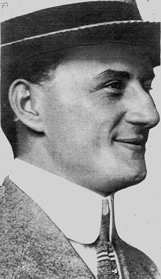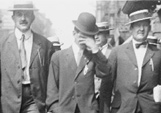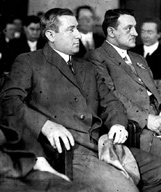- Home |
- About |
- Contact Us |
- RSS
Big Jack Zelig - Lower East Side Gang Leader
Leader of the old Monk Eastman gang and great defender of his own people.
Author of The Starker: Big Jack Zelig, the Becker-Rosenthal Case, and the Advent of the Jewish Gangster, available at Amazon.com.
Died: October 5, 1912 - New York, NY

"I never wanted this," Zelig confided to a trusted henchman shortly before his death. He was referring to the leadership of the gang that became Manhattan's earliest example of Jewish-controlled organized crime. But once he had it, Big Jack Zelig became infamous as the 'terror and commander' of the Lower East Side. "But for some," Professor Arthur Goren remembered, "(he was) the quarter's guardian as well."
From 1910 until 1912, Manhattan's Jewish district was Zelig's oyster. Small merchants paid his agents for protection, and bought tickets by the bundle when the gang threw a dance (or 'racket', in the parlance of the day). He rented his shtarkers at hefty rates to union leaders and politicians. Anyone who defied him risked violent consequences. But he also made his co-religionists safer from street crime than ever before. He chased away pimps, obstructed the drug trade, and sent any hooligans who assaulted Jews straight to the hospital. These acts of altruism would cause social workers, judges, and journalists to revere him for decades afterward.
The gangster who would one day generate headlines was born Zelig Zvi Lefkowitz on May 13, 1888, in a Norfolk Street tenement. His parents, Ephraim and Sarah, were Russian immigrants active in community life. They provided a positive example to Zelig, who was bright and did well in school. But he was one of nine children, and by the time the Lefkowitzes noticed that he was running wild with a youthful pickpocket gang led by Simon 'Crazy Butch' Erenstoft, it was too late.
It was through Erenstoft that Zelig met Monk Eastman, Manhattan's earliest celebrity gangster, whose fleet of shtarkers numbered over a thousand during its heyday. Another close companion was Max Zweifach, alias Kid Twist, a shrewd and relentless killer who took over the gang after Monk was shipped to Sing Sing in 1904.
The Eastmans regularly fought Paul Kelly's mob from the old Five Points district, but it's unlikely that Zelig participated in any of their battles. Although six feet tall and ruggedly built, he was strictly a pickpocket with no taste for violence. During those early years, his quick hands took wallets and jewellery, not lives. When caught, the teenager escaped arrest by crying until his accuser softened, a trick known as 'the baby game'. His skill at it rescued him from a lot of jail time.
Despite his success at playing the baby, Zelig was imprisoned twice for stealing- once in 1901 and again in 1906, when he was sent to Sing Sing for over two years. In late 1908 he returned to a changed gangland: Monk Eastman was in prison, and Kid Twist Zweifach had been killed at Coney Island by a vengeful Five Pointer named Louie the Lump. The current leader of the Eastman crew was a second-rate hoodlum named Abe Lewis, whose cousin had been Kid Twist's favorite bodyguard and companion in death.
Zelig needed money badly: by 1908 he had a common-law wife, Henrietta, to support, as well as her young son Harry. Lewis offered the ex-convict a way back into the fold- kill Frank 'Chick' Tricker, who had been leading the Five Pointers with Jack Sirocco since Paul Kelly's retirement. Zelig agreed to try despite being new to the art of murder, acknowledging that Zweifach had been slain by one of Chick's men. He attempted to shoot Tricker in the latter's saloon, but at the last minute his nerve failed him and he ran. Scared and disgraced, he fled to Chicago, where he decided to make a fresh start. His life did change there, but not in a way he anticipated.
Chicago had some criminal cliques that were hostile to newcomers. In January 1909 Zelig ran afoul of a gang of gamblers who hung out in a downtown cigar store. They lured him into a back room, jumped on him en masse, and beat him so severely that he almost died. Medical intervention pulled him through, but he was never the same afterward. He was harder and tougher, and had a violent streak that roared into life at the first sign of trouble.
Zelig returned to Manhattan in the summer of 1909, after his physical injuries healed. If anyone taunted him about his original flight from New York, he punched first and remonstrated later. His transformation became universal knowledge at the end of November 1910, when he went to the old Chatham Club in Doyers Street with friends.
They were accosted at their table by one Tommy Fitzpatrick, whose older brother Ritchie had challenged Kid Twist's leadership of the Eastmans and died for it. They ignored him at first, but when Fitzpatrick slashed one of his friends with a knife, Zelig erupted. He pounded the Irishman and two companions to a bloody pulp and went for a gun to finish the job. A policeman stopped him, but the beating itself awed the roomful of tough customers. Fitzpatrick retaliated a week later by ambushing him at a sports event, but Zelig put up such an impressive fight that Eastmans and other unconnected criminals gravitated toward him.
The Eastman gang had been drifting without a leader since Abe Lewis was sent to prison in 1909, and Zelig Lefkowitz's show of force placed the crown on his head by unanimous consent. He was now 'Big Jack' Zelig. He never asked for the honor, but once he had it, he remade the gang in his own image.
Under Monk Eastman and Kid Twist, money had been made via almost every form of crime and vice that paid. Zelig was more discriminating. A monogamist, he scorned prostitution as immoral. He was also against drugs: when Eastman, ravaged and desperate after years in prison, approached him in 1911 for cooperation in an opium selling racket, Zelig turned the old gangster away. He also stated in no uncertain terms that the gang would not provide muscle to gamblers during their petty wars. His Chicago experience forever embittered him against them.
Zelig concentrated instead on two lucrative fields, the first of which was the time-honored protection racket. In theory, merchants, madams, and gambling house owners paid to keep their premises and employees safe from all marauders, but in practice they were only guaranteed freedom from molestation by the extortionists. Such had been the case when Eastman and Zweifach ran the show. In contrast, Zelig honored his agreement to keep troublemakers away. One madam later testified that the $100 she paid his agents each month had been money well spent.
The second was labor racketeering. Both unions and employers hired gangsters to terrorize the opposing side, and picket lines were regular battlefields. Zelig sided with organized labor, refusing to offer strikebreaking services. His men protected picketers, attacked scabs, and swarmed into anti-union workplaces. Overseeing this undertaking was Benjamin Feinschneider, alias Dopey Benny Fein, a veteran pickpocket and organizational genius. Fein set the prices for a job, ensured that it got done, and cleaned up afterward. A mutual respect evolved into a friendship, and Fein became the gang's second in command.
Zelig is arguably the first Jewish gang boss to use the power of the underworld to protect the community. He drove away pimps that he found prowling the streets, sweet-talking gullible Jewish girls. Judge Jonah Goldstein, an esteemed jurist, remembered Zelig and his men riding trolley cars all over Manhattan, making sure that Jewish passengers were not harassed. He went down to the waterfront when a boatload of immigrants arrived and made short work of the thieves, con men, and panderers who intended to exploit the newcomers. Even Abe Shoenfeld, a private detective hired by reform groups to compile secret reports on Lower East Side crime, admitted to a reluctant admiration.
"At all times he (Zelig) has had the reputation… as being a good scrapper and above all a man of principle which readily understood is a quality seldom found amongst thieves. You may find honor but never principle," Shoenfeld wrote in August 1912. He also described the gang leader as having "prevented more hold-ups than a thousand policemen."
His altruism and fair dealing with those whom he was technically exploiting made Zelig popular. A dance that the gang held to raise money through ticket sales was widely attended. Abe Shoenfeld wrote, "Not only did crooks, gamblers, and others attend this ball, but (also) East Side businessmen, young and old, came to pay willing tribute to Jack Zelig. There was a large crowd of legitimate businessmen… Jack was very popular."

Battles with the Five Pointers made such experienced muscle necessary. Drive-by shootings and alley ambushes battered both sides and drove the cops to distraction. Throughout 1911 and 1912, gunfights, stabbings, and bombings were an almost weekly occurrence.
On December 2, 1911, a Five Pointer named 'Julie' Morrell crashed a ball thrown by the Boys of the Avenue. Zelig shot him full of holes and hurled him into the street. The following February Morrell's partner Frank Renesi was found with his head blown off. When Jonesy the Wop, a friend of both slain men, cursed Zelig as a 'Jew bastard' and attacked him in a restaurant with a knife, the Jewish gangster disarmed him and sliced up his face.
The violence peaked in early June 1912, when Zelig, Lefty Louis, and Whitey Lewis brawled with Tricker and a bevy of Five Pointers at a Chinatown dive, and all were arrested. When Zelig left the courthouse afterward, he was shot in the head by a gunman named Charles Torti, a known associate of Jack Sirocco. While surgeons operated on him, his boys nearly killed Tricker in a drive-by shooting.
Upon his discharge from the hospital, a weakened Zelig was sent to the Tombs prison to await bail. Once it was posted, he left for Hot Springs to complete his recovery. His departure took place days before New York witnessed a murder whose repercussions would send five men to Sing Sing's electric chair. This tragedy and ensuing miscarriage of justice would go down in history as the Becker-Rosenthal affair.
In July 1912 a waning gambler named Herman Rosenthal declared to the press and District Attorney's office that Police Lieutenant Charles Becker, who headed one of the NYPD's elite Strong Arm Squads, had been a silent partner in his gambling house for months. When Becker's superiors forced him to shut the place down, an enraged Rosenthal retaliated by exposing the policeman as a venal wolf in a cop's uniform. His allegations made the front pages of the daily papers and shocked New Yorkers with lurid tales of police-gambler collusion.

The latter theory appeared to be correct when three gamblers named Bald Jack Rose, Louis 'Bridgey' Webber, and Harry Vallon were arrested. Rose, who was also a graft collector and stool pigeon for Lieutenant Becker, admitted to hiring the shooters. But he stressed to District Attorney Whitman that he and his two confederates had acted as agents of Becker, who threatened them with jail time or worse if they did not silence Rosenthal forever.
Although all three were known enemies of the victim, the politically ambitious Whitman foresaw more glory in prosecuting a corrupt cop for murder instead of three scheming lowlifes. He hurried them before the grand jury, which promptly indicted Becker for murder, and granted them immunity in exchange for their testimony.
One by one, the hired guns were picked up. They were none other than Lefty Louis, Whitey Lewis, Gyp the Blood, and Dago Frank. With their leader out of town, they had somehow been persuaded to bend the rule about avoiding gamblers' feuds. Jack Rose would say that fear of Becker made them acquiesce, but Benny Fein met with Zelig in Boston and filled him in on what had really happened.
On the night of July 15, Rose had met with the quartet at Bridgey Webber's poker place, plied them with liquor and cocaine, and convinced them to beat up Rosenthal. After the target was located at the Metropole, the original agreement received a lethal modification. Harry Vallon, seething with hate, fired at Rosenthal first, and a coked-out Louis and Gyp mechanically followed suit. Whitey missed fire, and Dago Frank was not even present, having decided at the last minute to go home.
Zelig was furious. He knew that Lieutenant Becker had nothing to do with the crime. Jack Rose tried to hire him to kill Rosenthal in April, citing a long-standing personal feud. Zelig refused, but Rose did not give up. When the gangster was jailed in May on a bogus gun-carrying charge, the bald gambler offered to use his influence with Becker to get the charge dropped. All he wanted in exchange was for Zelig to order his men to rub Rosenthal out. Again he was rebuffed. Rose tried one more time, visiting Zelig in late June while he was in the Tombs prison awaiting bail for his role in the Chinatown brawl. Temper soured by pain from his bullet wound, the gang leader erupted and sent him running. Jack Rose made no further approaches- until Zelig was out of town and unable to interfere.
Now Herman Rosenthal was dead, and Becker and the gunmen were facing the electric chair. Zelig knew that he could not save his friends, as there had been too many witnesses to the shooting, but he could make sure that they had company on Death Row. Zelig notified Becker's defense team that he had exculpatory evidence to offer. He was no lover of cops, but he could not sit and watch an innocent man suffer the death penalty because Jack Rose successfully conned an ambitious district attorney. Shoenfeld's 'man of principle' was prepared to act.

Zelig would never take the stand. On the rainy evening of October 5, 1912, two days before Becker's trial was due to commence, the gangster left Segal's and went to a nearby barbershop for a shave. Then he boarded a Second Avenue streetcar to go home. As the trolley neared Thirteenth Street, Zelig was shot in the head from behind by 'Red' Phil Davidson, a pimp who poisoned horses as a sideline. Davidson, who was arrested without difficulty, said that he had killed Zelig for beating him and stealing his money -a sum he fixed as different times as $400 and $18.
No one believed him. Davidson was a noted coward and an easy tool for those with a stronger will. It was whispered that certain members of New York's political machine did not want Zelig to testify, worried that if Becker went free, Rose and his cohorts might bargain for their lives by handing some bigger fish to Whitman on a platter. Because the gang leader was too powerful to be silenced via threats, he was assassinated. His evidence died with him, and Lieutenant Charles Becker was convicted of murder and executed in Sing Sing's electric chair on July 30, 1915. Lefty Louis, Whitey Lewis, Gyp the Blood, and even Dago Frank, who had not even been present at Rosenthal's murder, were electrocuted in April 1914.
The funeral of Zelig Lefkowitz, alias Big Jack Zelig, was attended by thousands. His supporters hired a fleet of cars to transport his remains to Washington Cemetery in Brooklyn. Talmud Torah children and a choir conducted by Cantor Goldberg of the Shaare Shamayim synagogue accompanied the coffin. Benny Fein and other tough gangsters joined Zelig's family in shedding tears. The conservative Jewish press decried the dead man as a murderer and reprobate, but the residents of the Jewish quarter had benefited from the gangster's protection, and their grief was genuine. Many knew that he died because he intended to save a man's life.
Shortly after Zelig's death, Abe Shoenfeld wrote, "Jack Zelig is as dead as a door nail. Men before him - like Kid Twist, Monk Eastman, and others - were as pygmies to a giant. With the passing of Zelig, one of the most 'nerviest', strongest, and best men of his kind left us."
- Zelig’s sister-in-law, Amelia Lewis, became a celebrated attorney who helped reshape the American juvenile justice system. In 1967, thanks to a case that she argued, the United States Supreme Court ruled that juveniles charged with criminal offenses were entitled to the same procedural protections in juvenile courts that adults had in the criminal courts.
- Zelig’s great-grand-nephew, Jan Lefkowitz, portrays him in a series of webisodes titled Our Gotham. www.monk1903.com
Some of these sites were used as source material for this entry and may be of interest to those looking to learn more about this person/topic.
- Keefe, Rose. The Starker: Big Jack Zelig, the Becker-Rosenthal Case, and the Advent of the Jewish Gangster. Cumberland House Publishing, 2008
- Downey, Patrick. Gangster City: The History of the New York Underworld 1900-1935. Barricade Books, 2004
- Fried, Albert. The Rise and fall of the Jewish Gangster in America. Holt, Rinehart, and Winston, 1980
- Rockaway, Robert. But He Was Good to His Mother: The Lives and Crimes of Jewish Gangsters. Gefen Publishing House, 2000.
 Copy the text below to cite your paper or article:
Copy the text below to cite your paper or article: 